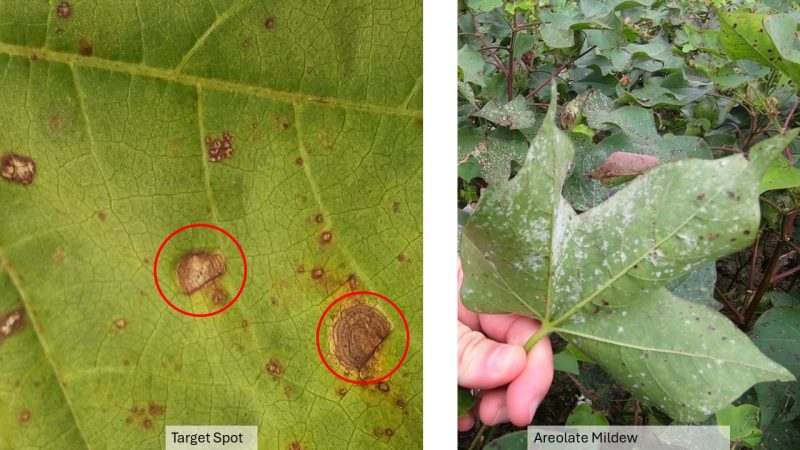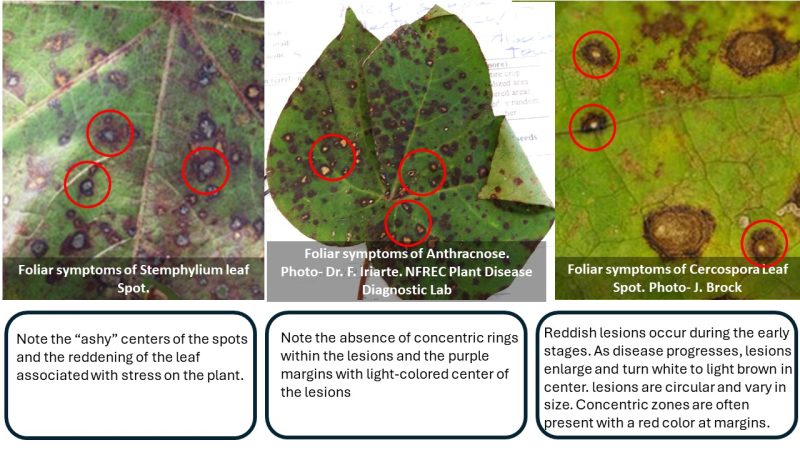Ethan Carter, UF/IFAS Regional Row Crop IPM Agent, Ian Small, UF/IFAS Crop Pathologist, and Bob Kemerait UGA Crop Pathologist
For cotton growers, market prices have been extremely discouraging. With prices in the 65-70¢ range, it’s hard to justify intensive crop management decisions, especially when many growers report a breakeven of 80-85¢. One important question that all cotton growers need to think about is, “Whether the cost of a fungicide application to manage loss from foliar diseases will be more costly than losses associated with not spraying?” When it comes to fungicide application, hindsight may be 20/20, but deciding whether a spray is needed can be difficult under the current economic conditions.
Florida’s 2024 growing season had a late start for some, and a greatly delayed planting window compared to other years. Heavy rains early on saturated fields, and deer pressure were root causes of many growers having to plant into late May and even June. Most cotton fields are now at the flowering stage, some well into it, while others are just beginning. The two primary foliar diseases that may require management in cotton are target spot and areolate mildew. Growers should not confuse either of these diseases (Figure 1) with the more common leaf spot complex (Figure 2) which becomes noticeable as the crop progresses towards maturity and typically does not respond to fungicide applications.

Figure 1. Target spot (left)and areolate mildew (right) symptoms in cotton. Fungicides can be effective at preventing defoliation and protecting yield when used in the early stages of disease development.
–

Figure 2. Leaf spot complex from left to right – Stemphylium, Anthracnose, and Cercospora. Fungicides are generally not warranted for these diseases, nor are they effective on all of them.
–
Target Spot
Target Spot typically occurs after canopy closure (lapped rows) and in the lower canopy where symptoms are not noticeable from a distance. Scouting for disease is recommended from the first to sixth week of bloom. For growers who are not able to scout regularly and want to spray preventively, targeting the 3rd or 4th week of bloom for fungicide application may be the best option. It is critical to protect against premature defoliation during the flowering and boll development stage. Target spot is common but does not cause significant yield loss every season. Field trials in Florida and Georgia have observed loss of 150 to 200 lbs. of lint. Once plants are well into defoliation, yield loss is nearly certain, and spraying is unlikely to provide and economic return.
–
Areolate Mildew
Areolate Mildew can occur earlier than target spot and prior to canopy closure, but it normally surfaces in July or August. This disease also begins in the lower canopy and symptoms are not noticeable from a distance. It can be easily identified by the presence of white to grayish colored spores on the underside of the leaf (Figure 1) and in some varieties the upper leaf surface of infected leaves turns a purple color. The general recommendation is to scout for disease and if you find it developing before the sixth week of bloom, it is advisable to make a fungicide application and possibly a second application 14 days later if conditions are favorable. Fungicide applications at the first and third week of bloom have been shown to be optimal timing for prevention of premature defoliation. After the sixth week of bloom the economic return on fungicide application begins to decline.
–
To Summarize
Growers most likely to see benefit from applying fungicides to cotton have fields with: 1) high yield potential, 2) excellent growth, 3) disease appears at or soon after first bloom, and 4) fungicide applications are made by 3rd week of bloom. Field testing has shown products like Priaxor and Miravis Top are effective on both diseases, while Headline is only effective on target spot.
Growers least likely to see a benefit from a fungicide application are those who a) have poor growth and a crop suffering from nutrient deficiency, b) apply fungicide where disease never develops, or c) apply fungicide after disease has caused 25% or more defoliation. For more information, contact your local Extension Office.
–
Other Helpful Articles:
2022 Panhandle Ag – Update on Cotton Diseases: Target Spot and Areolate Mildew
2021 Panhandle Ag – Time to Protect your Cotton from Premature Defoliation due to Foliar Diseases
- 2025 Peanut Field Day Recap & Speaker Handouts - August 29, 2025
- Peanut Foliar Diseases Exploding Across Florida - August 22, 2025
- Provisional Nitrogen Fertilization Recommendation for Florida Cotton for the 2025 Season - June 20, 2025
